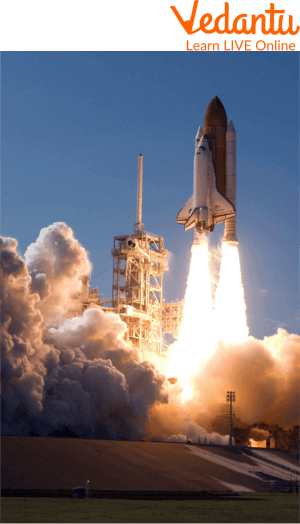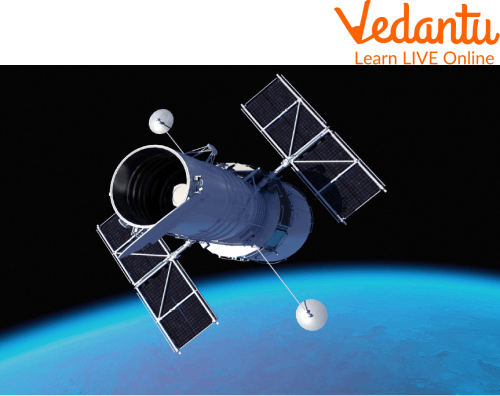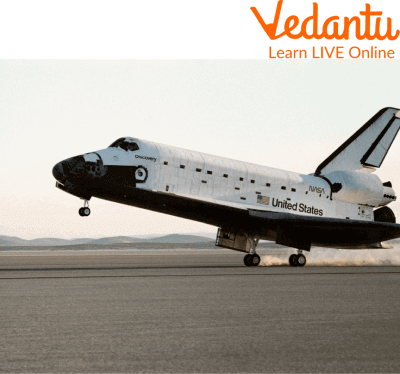




Overview of Space Shuttle
Whenever we see up at the sky, we always want to know what's there in space. Not only do we want to know, but also we want to go there, and for that curiosity, scientist has made a space shuttle. Do you know what's space shuttle is? If not, then don't worry.
Today we will learn about the space shuttle, but before starting, let's talk a little bit and introduce it. So, the space shuttle was a NASA space transportation system which travelled between earth and earth's orbit. It carried as many as seven astronauts at a time to and from space.

Space Shuttle Launches into Space
But to know more about spacecraft for kids, let's read this article. Here we will learn about how to make the space shuttle, and it works. And will also discuss some space shuttle facts for kids and many more interesting things related to the space shuttle. So, let's begin.
Who Invented Space Shuttle?
John Young and Robert Crippen launched the space shuttle program by piloting Columbia to space and returning successfully two days later on April 12, 1981. Space shuttle astronaut Sally Ride became the first U.S. woman in space as part of the Challenger crew in 1983.
The program was a tremendous success for NASA, but in 1986 NASA endured several tragedies. A string of successful missions was broken when Challenger disintegrated a second after liftoff, killing its seven members of the crew.
After this incident, the space shuttle program was suspended. No shuttle was launched for nearly three years. In April 1990, with the successful missions of discovery, the program rebounded. This flight placed the Hubble Space Telescope into orbit.

Hubble Space Telescope
How to Make Space Shuttle?
The space shuttle was made of three parts. The first one is the orbiter, the second is the external tank and the third is solid rocket boosters. The orbiter looked like an aeroplane. The orbiter flew around Earth. The astronauts controlled the space shuttle and lived in this part. NASA had five orbiters: Atlantis, Challenger, Columbia, Discovery and Endeavour. The external tank contains orange fuel. The two thin cylinders that look like rockets are the solid rocket booster. They gave the extra fuel to the rocket to lift it from Earth's gravity.
How does the Space Shuttle Work?
The space shuttle launched into earth's orbit like a rocket. But it returned like a glider aeroplane.

Space Shuttle Landing
The solid rocket boosters and the main engines on the orbiter helped the shuttle blast off from Earth's gravity like a rocket. The two boosters dropped off the shuttle after two minutes of launch. They landed in the ocean; a boat picked the boosters out of the ocean, so they were used again for the next flight. The external tank contains organic fuel. It dropped off the orbiter after it had used all the fuel in the tank. They don't use external tanks again and would burn up over Earth.
When the shuttle orbiter landed on Earth, it landed like an aeroplane. Wheels came from underneath the orbiter. It landed on the runway and stopped. Then NASA prepared it to fly on another mission.
Facts About Space Shuttle
The space shuttle was the first-ever reusable spacecraft. Space rockets aren’t reusable; they only have a one-time use.
Space shuttles were launched in 1981 for the first time. The shuttle was named Columbia.
NASA retired the space shuttle in 2011. The last landing of the space shuttle, called Atlantis. It landed at the Kennedy Space Centre in Florida on July 21st, 2011.
The space shuttle could carry up to 7 astronauts at a time. Every astronaut would participate in scientific experiments, release and capture satellites and even help build the International Space Station.
Space shuttles are now retired, but you can still see some of them in museums. They are located in America.
Summary
So in this article, we learned about an exciting thing, and that is a space shuttle. We learned about the space shuttle in a very wonderful and easy way. We discussed so many interesting points which were related to space shuttles we discussed how to make a space shuttle, how a space shuttle works, what are some interesting facts which are related to the space shuttle. We also discussed who invented the space shuttle.
FAQs on How to Make Space Shuttle?
1. What were the main parts of a NASA Space Shuttle?
The Space Shuttle was a complex vehicle with three main components working together. These were:
- The Orbiter: The airplane-like vehicle that housed the astronauts and cargo.
- The External Tank: A large orange tank that held the liquid fuel for the Orbiter's main engines.
- Two Solid Rocket Boosters (SRBs): A pair of powerful rockets that provided most of the thrust during the first two minutes of launch.
2. How is a real space shuttle constructed?
Building a real space shuttle was a major engineering feat. It wasn't built in one piece but assembled from its three core parts. The Orbiter was constructed from a lightweight aluminium alloy frame covered with special heat-resistant tiles. The massive External Tank was built to hold super-cooled liquid hydrogen and oxygen. The powerful Solid Rocket Boosters were manufactured in segments and assembled before launch. All these parts were brought together at the launch site for final assembly.
3. How fast did the space shuttle travel to stay in orbit?
To remain in orbit around the Earth, the Space Shuttle had to travel at an incredible speed. It reached an orbital velocity of approximately 28,000 kilometres per hour (about 17,500 miles per hour). This speed was necessary to counteract Earth's gravity and prevent the shuttle from falling back to the ground.
4. What replaced the Space Shuttle for taking astronauts to space?
After the Space Shuttle program ended in 2011, NASA began using different spacecraft. Today, astronauts travel to the International Space Station (ISS) on capsules developed by commercial companies like SpaceX (Crew Dragon) and Boeing (Starliner). For future deep space missions to the Moon and Mars, NASA has developed the Orion spacecraft.
5. What materials can I use to make a simple space shuttle model for a school project?
To build a simple model of a space shuttle, you can use common craft supplies. A good starting point includes:
- For the body (Orbiter): A plastic bottle or a cardboard tube.
- For the wings and tail: Stiff cardboard or foam board.
- For the External Tank: A larger cardboard tube or another plastic bottle.
- For the Boosters: Two smaller cardboard tubes (like from paper towels).
- For details: White and black paint, glue, and scissors.
6. Why was the Space Shuttle designed to be reusable?
The main reason for making the Space Shuttle reusable was to reduce the cost of space travel. Earlier rockets like the Saturn V were used only once and then discarded. The Space Shuttle's Orbiter was designed to be flown up to 100 times, landing like an airplane after each mission. The Solid Rocket Boosters were also recovered from the ocean and reused. This approach was intended to make launching satellites and astronauts more economical.
7. Are space shuttles still used by NASA today?
No, NASA's Space Shuttle program is no longer active. The program was officially retired in July 2011 after the final mission of the Space Shuttle Atlantis, STS-135. The surviving orbiters—Discovery, Atlantis, and Endeavour—are now displayed in museums across the United States.
8. How was the Space Shuttle different from earlier rockets?
The Space Shuttle was fundamentally different from earlier rockets like the Apollo-era Saturn V. The biggest difference was reusability; the shuttle's Orbiter could land on a runway and fly again, whereas previous rockets were single-use. Secondly, the shuttle was a multipurpose vehicle that could deploy satellites, repair them in orbit, and serve as a science laboratory, unlike earlier capsules which were purely for transportation.
9. What did the Space Shuttle do on its missions?
The Space Shuttle was a versatile workhorse in space with several important jobs. Its primary missions included:
- Deploying satellites: It carried many famous satellites into orbit, including the Hubble Space Telescope.
- Construction: It was crucial for building and servicing the International Space Station (ISS).
- Scientific research: It carried Spacelab and other modules, allowing astronauts to conduct experiments in microgravity.
- Repair missions: Astronauts used the shuttle's robotic arm to capture and repair satellites in orbit.
10. What was the biggest challenge in making the Space Shuttle return safely to Earth?
The biggest challenge for a safe return was managing the extreme heat generated during re-entry into Earth's atmosphere. As the Orbiter travelled at hypersonic speeds, friction with the air heated its outer surface to over 1,650°C (3,000°F). To survive this, the shuttle was covered in a special Thermal Protection System made of reinforced carbon-carbon panels and silica tiles, which insulated the aluminium frame and the astronauts inside from the intense heat.









